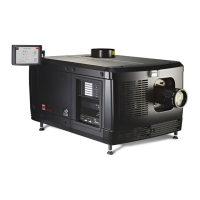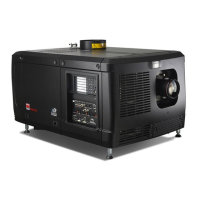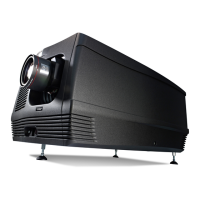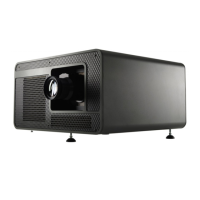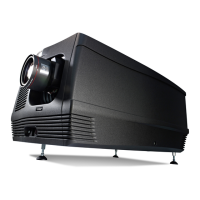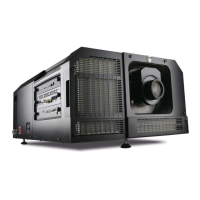R5906790 /04 Athena 133
15.2 Vacuum cleaning of the dust filters and filter
foams
When to vacuum the dust filters and foams?
The dust filters and foams of the projector should be checked every month. If any of the filters or foams are
contaminated with dust then cleaning the filter and foam with a vacuum cleaner should be sufficient. In case
the filter or foam feels greasy, they must be washed instead. See cleaning procedure “Washing and drying the
dust filters”, page 133.
Grease on the filters and foams can build up after several months in an environment contaminated
with greasy air. Note that areas where popcorn is consumed are subject to greasy air.
This procedure assumes that the dust filters and foams are removed from the projector. For removal
and installation of the filters and foams, see procedures “Check the dust filters and foams”, page
132.
Required tools
Vacuum cleaner with soft brush suction nuzzle.
How to vacuum-clean the dust filter?
1. Carefully vacuum the air inlet side of the dust filter. Use a vacuum cleaner with a soft brush suction nuzzle.
The air inlet side of the dust filter is the side which is surrounded with a glue edge.
Tip: Lightly tap the filter on its dusty side to expel heavy dust contamination.
Tip: Compressed air is also permitted to clean the filters but take care not to damage them.
Caution: Do not damage the dust filter. Replace damaged dust filters immediately.
How to vacuum-clean the filter foam?
1. Carefully vacuum the filter foam. Use a vacuum cleaner with a soft brush suction nuzzle.
Caution: Do not damage the filter foam. Replace damaged foams immediately.
15.3 Washing and drying the dust filters
About filter washing and drying
For environments where popcorn grease and such can contaminate the filters, Barco advises the client to
purchase one extra set of filters to cover drying time, as well as taking following extra precautions and
instructions pertaining to filter cleaning and drying.
Cleansing agent
To clean sticky, greasy dust filters we suggest usage of Sodium carbonate crystals (Na
2
CO
3
). Sodium
carbonate (Often called washing soda, soda crystals, or sal soda in the detergent section of stores) is
widely used to effectively remove oil, grease, alcohol stains … The product itself is relatively safe, sodium
carbonate is used in toothpastes and as a food additive (E500). Potential Hazards are described in the section
“Safety precautions Hazardous Chemicals”, page 18.
Maintenance procedures

